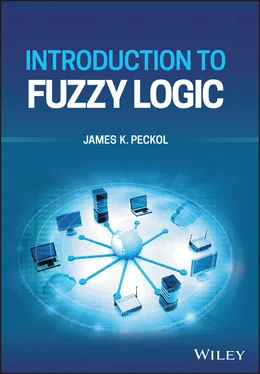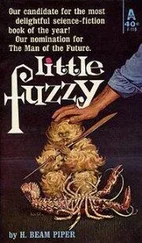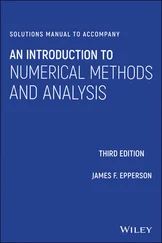James K. Peckol - Introduction to Fuzzy Logic
Здесь есть возможность читать онлайн «James K. Peckol - Introduction to Fuzzy Logic» — ознакомительный отрывок электронной книги совершенно бесплатно, а после прочтения отрывка купить полную версию. В некоторых случаях можно слушать аудио, скачать через торрент в формате fb2 и присутствует краткое содержание. Жанр: unrecognised, на английском языке. Описание произведения, (предисловие) а так же отзывы посетителей доступны на портале библиотеки ЛибКат.
- Название:Introduction to Fuzzy Logic
- Автор:
- Жанр:
- Год:неизвестен
- ISBN:нет данных
- Рейтинг книги:4 / 5. Голосов: 1
-
Избранное:Добавить в избранное
- Отзывы:
-
Ваша оценка:
- 80
- 1
- 2
- 3
- 4
- 5
Introduction to Fuzzy Logic: краткое содержание, описание и аннотация
Предлагаем к чтению аннотацию, описание, краткое содержание или предисловие (зависит от того, что написал сам автор книги «Introduction to Fuzzy Logic»). Если вы не нашли необходимую информацию о книге — напишите в комментариях, мы постараемся отыскать её.
Learn more about the history, foundations, and applications of fuzzy logic in this comprehensive resource by an academic leader Introduction to Fuzzy Logic
Introduction to Fuzzy Logic
Introduction to Fuzzy Logic
Introduction to Fuzzy Logic — читать онлайн ознакомительный отрывок
Ниже представлен текст книги, разбитый по страницам. Система сохранения места последней прочитанной страницы, позволяет с удобством читать онлайн бесплатно книгу «Introduction to Fuzzy Logic», без необходимости каждый раз заново искать на чём Вы остановились. Поставьте закладку, и сможете в любой момент перейти на страницу, на которой закончили чтение.
Интервал:
Закладка:
Table of Contents
1 Cover
2 Title Page
3 Copyright Page
4 Dedication Page
5 PrefaceStarting to Think Fuzzy and Beyond Organizing the Book The Chapters The Appendices The Audience Notes to the Instructor
6 Acknowledgments
7 About the Author
8 Introduction I.1 Introducing Fuzzy Logic, Fuzzy Systems, and • • • • • I.2 Philosophy I.3 Starting to Think Fuzzy – Fuzzy Logic Q&A I.4 Is Fuzzy Logic a Relatively New Technology? I.5 Who Is Using Fuzzy Logic in the United States? I.6 What Are Some Advantages of Fuzzy Logic? I.7 Can I Use Fuzzy Logic to Solve All My Design Problems? I.8 What's Wrong with the Tools I'm Using Now? I.9 Should I Implement My Fuzzy System in Hardware or Software? I.10 Introducing Threshold Logic I.11 Moving to Perceptron Logic I.12 Testing and Debugging I.13 Summary
9 1 A Brief Introduction and History 1.1 Introduction 1.2 Models of Human Reasoning 1.3 Building on the Past – From Those Who Laid the Foundation 1.4 A Learning and Reasoning Taxonomy 1.5 Crisp and Fuzzy Logic 1.6 Starting to Think Fuzzy 1.7 History Revisited – Early Mathematics 1.8 Sets and Logic 1.9 Expert Systems 1.10 Summary Review Questions
10 2 A Review of Boolean Algebra 2.1 Introduction to Crisp Logic and Boolean Algebra 2.2 Introduction to Algebra 2.3 Getting Some Practice 2.4 Getting to Work 2.5 Implementation 2.6 Logic Minimization 2.7 Summary Review Questions
11 3 Crisp Sets and Sets and More Sets 3.1 Introducing the Basics 3.2 Introduction to Classic Sets and Set Membership 3.3 Classical Set Theory and Operations 3.4 Basic Crisp Applications – A First Step 3.5 Summary Review Questions
12 4 Fuzzy Sets and Sets and More Sets 4.1 Introducing Fuzzy 4.2 Early Mathematics 4.3 Foundations of Fuzzy Logic 4.4 Introducing the Basics 4.5 Introduction to Fuzzy Sets and Set Membership 4.6 Fuzzy Membership Functions 4.7 Fuzzy Set Theory and Operations 4.8 Basic Fuzzy Applications – A First Step 4.9 Fuzzy Imprecision And Membership Functions 4.10 Summary Review Questions
13 5 What Do You Mean By That? 5.1 Language, Linguistic Variables, Sets, and Hedges 5.2 Symbols and Sounds to Real‐World Objects 5.3 Hedges 5.4 Summary Review Questions
14 6 If There Are Four Philosophers… 6.1 Fuzzy Inference and Approximate Reasoning 6.2 Equality 6.3 Containment and Entailment 6.4 Relations Between Fuzzy Subsets 6.5 Inference in Fuzzy Logic 6.6 Summary Review Questions
15 7 So How Do I Use This Stuff? 7.1 Introduction 7.2 Fuzzification and Defuzzification 7.3 Fuzzy Inference Revisited 7.4 Fuzzy Inference – Single Premise 7.5 Fuzzy Inference – Multiple Premises 7.6 Getting to Work – Fuzzy Control and Fuzzy Expert Systems 7.7 Summary Review Questions
16 8 I Can Do This Stuff!!! 8.1 Introduction 8.2 Applications 8.3 Design Methodology 8.4 Executing a Design Methodology 8.5 Summary
17 9 Moving to Threshold Logic!!! 9.1 Introduction 9.2 Threshold Logic 9.3 Executing a Threshold Logic Design 9.4 The Downfall of Threshold Logic Design 9.5 Summary Review Questions
18 10 Moving to Perceptron Logic ! ! ! 10.1 Introduction 10.2 The Biological Neuron 10.3 The Artificial Neuron – a First Step 10.4 The Perceptron – The Second Step 10.5 Learning with Perceptrons – First Step 10.6 Learning with Perceptrons – Second Step 10.7 Testing of the Perceptron 10.8 Summary Review Questions
19 Appendix A Requirements and Design Specification A.1 Introduction A.2 Identifying the Requirements A.3 Formulating the Requirements Specification A.4 The System Design Specification A.5 System Requirements Versus System Design Specifications
20 Appendix B Introduction to UML and Thinking Test B.1 Introduction B.2 Use Cases B.3 Class Diagrams B.4 Dynamic Modeling with UML B.5 Interaction Diagrams B.6 Sequence Diagrams B.7 Fork and Join B.8 Branch and Merge B.9 Activity Diagram B.10 State Chart Diagrams B.11 Preparing for Test B.12 Summary
21 Bibliography Further Reading
22 Index
23 End User License Agreement
List of Tables
1 Chapter 4Table 4.1 Activities and grades of membership.
2 Chapter 6Table 6.1 Modus ponens fuzzy conclusions.Table 6.2 Modus tollens fuzzy conclusions.
3 Chapter 7Table 7.1 Fuzzy implication functions.Table 7.2 Heater ON temperature and extent.Table 7.3 System behavior.
4 Chapter 9Table 9.1 AND gate T = 2.Table 9.2 OR gate T = 1.Table 9.3 Truth table.Table 9.4 K‐map.Table 9.5 K‐map.Table 9.6 Truth table, weights, WS , output.Table 9.7 K‐map.Table 9.8 Truth table, weights, W S,output.
5 Chapter 10Table 10.1  NAND Gate T > −2Table 10.2
NAND Gate T > −2Table 10.2  NOR Gate T > −1Table 10.3
NOR Gate T > −1Table 10.3  NOT Gate T > 0
NOT Gate T > 0
6 Appendix BTable B.1 Common UML diagrams.
List of Illustrations
1 Chapter 1 Figure 1.1 Crisp and fuzzy circles. Figure 1.2 Membership in subset H . Figure 1.3 Membership functions for “close to 7.” Figure 1.4 Bottles of liquids – front side. Figure 1.5 Bottles of liquids – back side.
2 Chapter 2 Figure 2.1 Algebraic AND and OR operations. Figure 2.2 Truth‐table proof.Figure 2.3 Single‐variable truth table.Figure 2.4 Two‐variable truth table.Figure 2.5 Verifying De Morgan's Law.Figure 2.6 De Morgan's tea vending machine.Figure 2.7 Basic logic devices.Figure 2.8 Logic gates.Figure 2.9 Logic circuit.Figure 2.10 Logic circuit.Figure 2.11 Tea circuit.Figure 2.12 Basic truth tables.Figure 2.13 Basic truth table.Figure 2.14 Four‐variable K‐Map.Figure 2.15 Four‐variable K‐Map.Figure 2.16 Four‐variable K‐Map.Figure 2.17 Four‐variable K‐Map.Figure 2.18 Three‐input system.Figure 2.19 BCD to Excess 3 decoder.Figure 2.20 BCD to Excess 3 encoder block diagrams.
3 Chapter 3Figure 3.1 Three sets.Figure 3.2 Crisp set and universe of discourse.Figure 3.3 Two sets of light bulb states.Figure 3.4 Four basic logical operations.Figure 3.5 Motor control subsets.Figure 3.6 Basic crisp set symbols.Figure 3.7 Basic universe of discourse.Figure 3.8 Viewing a movie.Figure 3.9 Expressing an opinion‐0.
4 Chapter 4Figure 4.1 Real‐world problems fuzzy logic solution.Figure 4.2 Universe of discourse and three subsets.Figure 4.3 Crisp and fuzzy membership values.Figure 4.4 Membership functions for “ close to 7 .”Figure 4.5 Fuzzy set membership vs. probability.Figure 4.6 Information from the backs of the bottles.Figure 4.7 Basic fuzzy set symbols.Figure 4.8 Four basic logical operations.Figure 4.9 Basic universe of discourse with two subsets.Figure 4.10 Viewing a movie.Figure 4.11 Expressing an opinion‐1, 2.Figure 4.12 Expressing an opinion‐3.Figure 4.13 Expressing an opinion‐4.Figure 4.14 Simple crisp and fuzzy adult membership functions.Figure 4.15 Linear increasing and decreasing fuzzy membership functions.Figure 4.16 Degree of membership.Figure 4.17 Linear increasing and decreasing fuzzy membership functions.Figure 4.18 Increasing and decreasing fuzzy membership functions.Figure 4.19 Basic linear and bell‐shaped fuzzy membership functions around 5...Figure 4.20 Basic linear membership functions around and restricted domains....Figure 4.21 Universe of discourse.Figure 4.22 Set of support.Figure 4.23 Sigmoid membership curves growth and decline.Figure 4.24 PI membership curve.Figure 4.25 Beta membership curve.Figure 4.26 Gaussian membership curves.Figure 4.27 Simple membership functions.Figure 4.28 Using a membership function.Figure 4.29 Using a membership function.Figure 4.30 Using a membership function.Figure 4.31 Using membership functions.
Читать дальшеИнтервал:
Закладка:
Похожие книги на «Introduction to Fuzzy Logic»
Представляем Вашему вниманию похожие книги на «Introduction to Fuzzy Logic» списком для выбора. Мы отобрали схожую по названию и смыслу литературу в надежде предоставить читателям больше вариантов отыскать новые, интересные, ещё непрочитанные произведения.
Обсуждение, отзывы о книге «Introduction to Fuzzy Logic» и просто собственные мнения читателей. Оставьте ваши комментарии, напишите, что Вы думаете о произведении, его смысле или главных героях. Укажите что конкретно понравилось, а что нет, и почему Вы так считаете.












